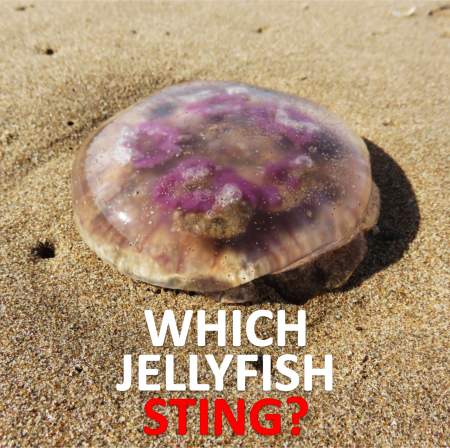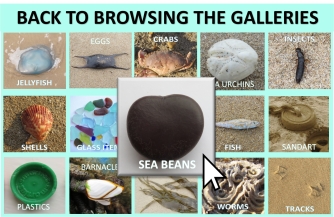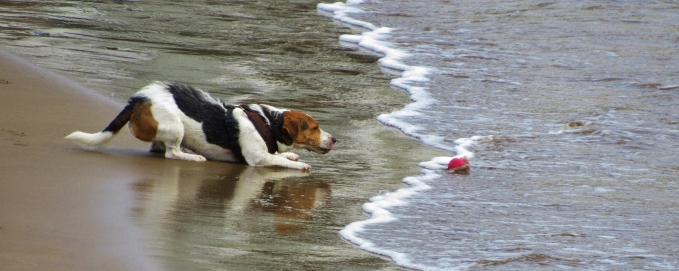
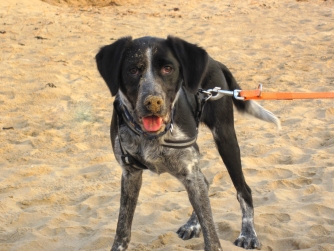

KEEPING YOUR DOG SAFE
ON THE BEACH
On any beach, virtually anything can wash up, whether is dropped from boats, washed from exposed tips, sewerage systems, farms, litter louts, oil rigs, or other countries ... or, of course, the natural underwater world.
Natural creatures like seaweed, jellyfish and decaying animals can land on the beach as well as manmade stuff such as wax, plastics, and fishing gear. All of these can be potentially hazardous to our four-legged friends.
Dogs are naturally inquisitive and investigate everything by sticking their nose in it
or by popping it in their mouth for an exploratory chew.It's just the way they are.
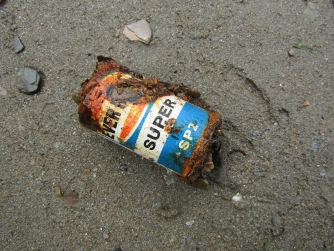
This battery may no longer be 'Ready' but it is still hazardous.
Don't panic!
Thousands of dog walks take place on beaches every day and there are relatively few calamities. What we offer here are simply some of the potentially dangerous items that you can look out for to minimise any risks.
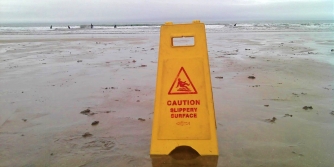
Scroll down the page or jump straight to:
Drinking too much sea water can make a dog sick just beause of the amount of salt in it. Make sure there is always fresh water on hand to reduce the temptation.
If the sand is too hot for you to walk on, it's probably too hot for your dog too and he doesn't have the luxury of popping a pair of flip flops on. Hot sand can burn and blister paws.
Dogs can get sun burn too! Areas of no fur (like noses) and thin fur can burn. Pop your pooch under a brolly. Or leave beach walks until a cooler part of the day.
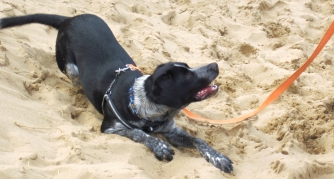
Sadly some careless folks leave broken glass, half-buried instant barbecues (both sharp and hot..!) and other nasties for our fragile feet -be they human or canine. Add to that fishing hooks which are a devil to pull out.
But it's not just careless humans who leave sharp stuff. Rocks can be naturally sharp, especially when they are covered in sharp barnacles. Always worth checking your dog's feet after an explore.
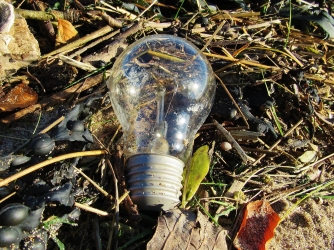
How on earth do some light bulbs survive on a beach?
Weever fish lie buried in the sand with just their barbs exposed. A dog treading on it will soon know about it - it can be incredibly painful. Go to a vet if you want to ensure the barbs are completely removed and for pain relief methods. The pain typically lasts hours rather than days and the sting is generally not as serious as the pain suggests.Serious problems usually onlu occur when there are underlying health problems. For more...
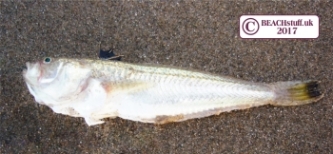
Stepping on a weever fish can be extremely painful for dogs.
Adders
Adders often live in sand dunes and can sometimes find their way onto the beach. Left alone they will just do their own thing but if they feel threatened (say if a large curious dog face gets a bit too close), they may bite.
As soon as you are aware that your dog has been bitten (or think he may have been), get him to a vet. Do not let your dog walk but carry him as this reduces the risk of the venom travelling around the body. Bathe the wound with cold, fresh water if possible.
Generally, the sooner you can get your dog to a vet, the better his chances of survival.
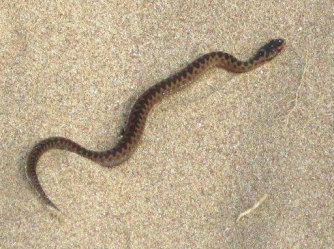
Adder bites can be fatal if not treated quickly
Crabs
Crabs can pinch pretty hard when they want to and cling on as if their lives depended on it. The best way to get a crab to release is to put it on the ground or in the water and it will scuttle off by itself.

The Velvet Swimming crab has particularly deep-cutting pincers
Jellyfish
Most of the jellyfish that wash onto UK beaches are not big stingers. However, some dogs can be allergic and others can eat so many that they get sick - possibly as much becuse of the salt content as anything else. If you have concerns about a bad reaction, or if you fear the culprit was a Portuguese Man o' War (pictured below) or Lions Mane, please get immediate advice from a vet.
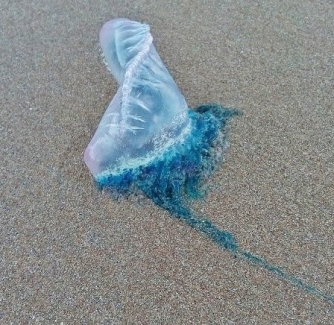
Portuguese Men o' War are not common in the UK but have a very dangerous sting whether in the sea or on the beach
Sadly there is always going to be the risk of potentially poisonous matter washing up on a beach - and what may be harmless to one dog could cause an allergic reaction in another. However, there are a couple of particularly infamous poison sources.
Water Hemlock Droplet root
This is an incredibly poisonous plant (to humans as well as dogs) and the poison is particularly concentrated in the roots which are known to wash up on beaches (water hemlock grows by streams so it has a relatively easy journey to beaches). If eaten, the poison is both deadly and fast so getting your dog to a vet as soon as possible is essential.

Water hemlock is one of the most posionous plants in the UK
Sea Chervil
This is a colony of creatures called bryozoan, looks like a thick, squishy sea weed. It is said togive humans Dogger Bank Itch but more worryingly, there are many reports of dogs reacting badly,even dying, having eatenit. It is thought that chervil has the ability to collect and store toxins from its own environment. Any suspicions that a dog might or has become ill after having eaten it, warrants an urgent trip to the vet.
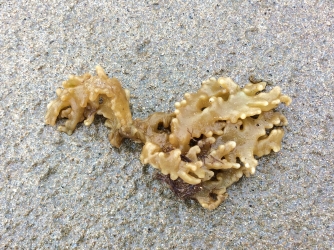
Palm oil
Ships can legally dump palm oil into the sea which means that sometimes it is washed up on our beaches - as a white(ish) waxy mass.
Palm oil is not poisonous itself (after all, it is in an ingredient in many of our processed foods) but it is very good at collecting all sorts of bacteria and toxins from other waste products which can prove poisonous if eaten by dogs. Additionally, its waxy texture can cause dogs extreme digestive problems. If your dog eats palm oil, it is important to get him to a vet as soon as possible.
It that it can be tricky to ID palm oil as there are a lot of substances commonly washed up which it resembles. Paraffin wax and surf wax, used to wax surf boards, are often mistaken for palm oil for example.
The photographs of palm oil below are courtesy of the National Trust - Norfolk Coast
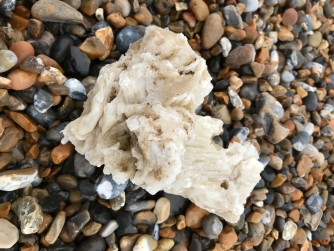

Alabama Rot
The actual causes of this horrible disease are not known but most dogs affected are thought to have been walking in muddy or wooded areas rather than on the beach.
However, if you do see lesions or ulcers (appearing as patches of red skin or open ulcers on paws, legs, face or even the belly and chest), it is important to get the advice of a vet in case it is Alabama Rot.



